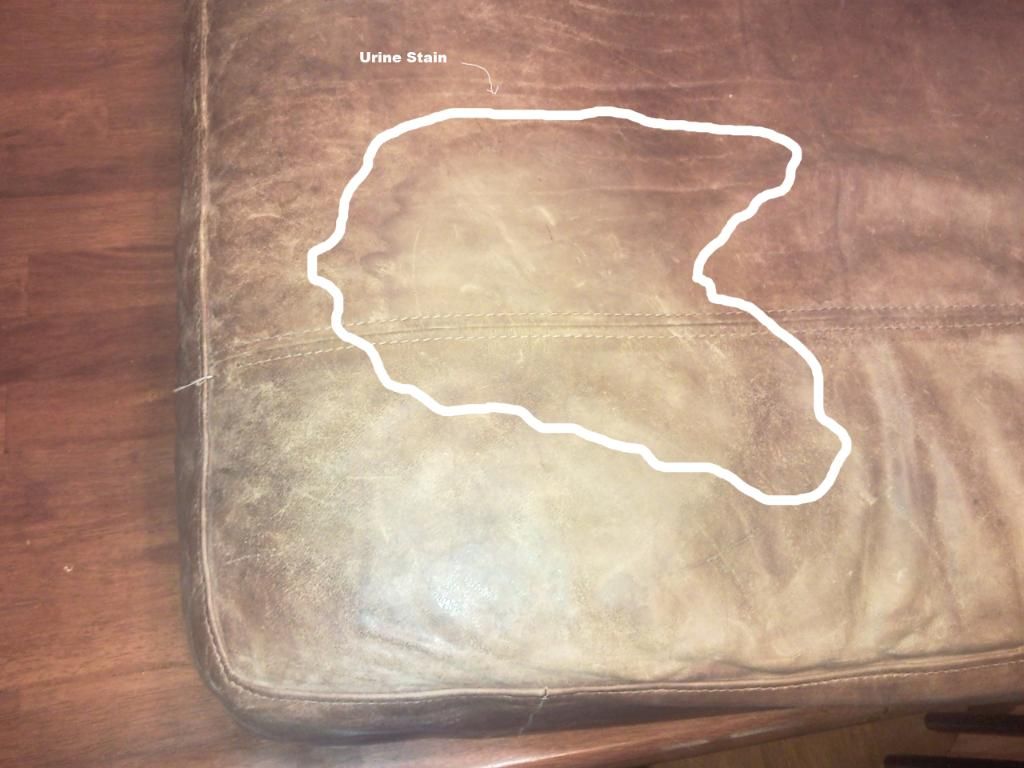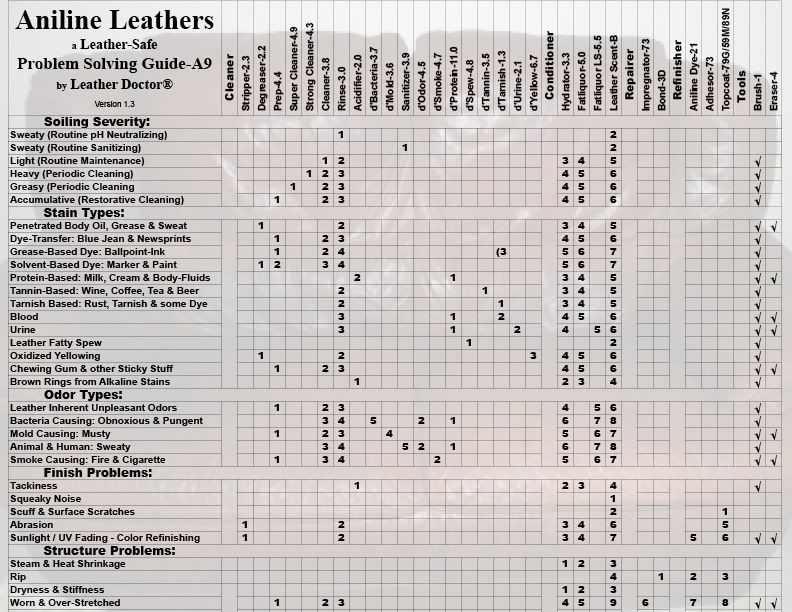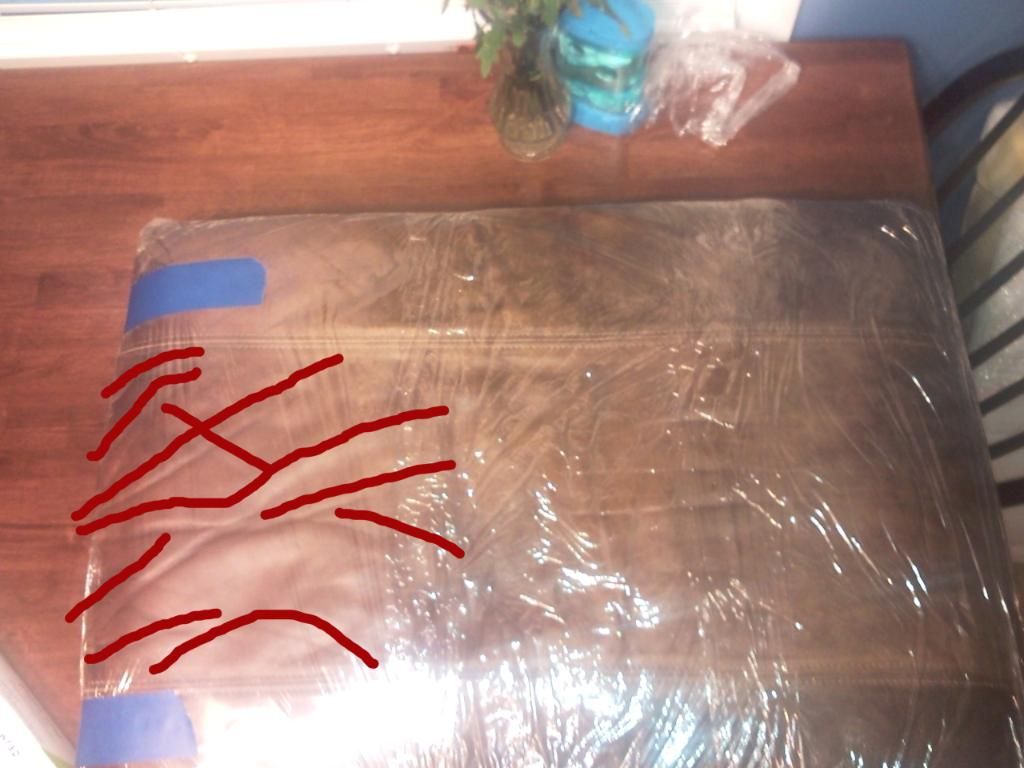
Picture #13 the urine stain.
How do you want to deal with this problem?
Among all leather stains – urine stain is the most destructive to the chemistry integrity of the leather. Yours is a very mild case, from a small boy and only once; the least you could do is to remove the soiling particulates by the Hydrator-3.3 process. This is done by heavy saturation the spots and laying absorbent tissue over it to allows the soiling particulate to be trap as it wick through the tissue extension of the leather surface.
The functions of the Hydrator-3.3 are multipurpose, especially dealing with the structure of the leather and understanding the why and how, helps dealing with the task at hand.
You have to determine why you want to hydrate the leather – removing suspended soiling from within the thickness of the leather to the surface will require a full saturation through its thickness, you may refer to more information below. To soften the thickness of the leather is one example for a full hydration. Surface mist hydration is for checking “surface interfacial tension” to avoid blotchiness for subsequent application.
Assuming all the contamination is removed accordingly, (refer to the Aniline Problem solving guide below) hydrating is the last step of the wet soiling removing process. Soiling removal process is done with towel extraction; indirect gentle towel extraction is done by rubbing, scudding or staking a smooth spatula or other object like a spoon over the towel.
Fatliquor replenishing is done when the leather is fully hydrated so that the fatliquor could be easily redistributed once penetrated among the relaxed and separated leather fibrils. When each fibril is lubricated, the fibers will slight over one another smoothly when dry to prevent the leather from cracking.
Topcoat is water-based as well; however, it is best done when the leather is fully dry for at least a full day (See info on Topcoat below). Note that topcoat will lock in all the beauty of the leather and all the ugliness of stains, as both will be enhanced and magnified. The decision is yours, as it is not easy to remove the topcoat to reach the buried stains if any.
If you love this Flexsteel which I respect it “like a Mercedes of Sofa” I would want to do it right and keep it for life – it is already one of America’s very best of leather furnishing.
I restore much such “Flexsteel” leather furniture through the years so I know the quality and appreciate them.
You should check out the brand new price, and the potential you can put it right near to its original value. All your trouble will be very worth it, by the thousands and not hundreds of dollars you have saved.
Non-stick, rub-resistant protection will prolong the leather finish (colorcoat and topcoat) from wearing off too soon.

Leather-Safe Aniline Leather Problem Solving Guide-A9
Urine
Urine is a waste discharge from human or animal, besides the typical coloration it has the uric acid and the ammonium salt to deal with. When deposited urine attracts the natural bacteria from the atmosphere and starts to ferments, a putrid odor will develop from the protein component of the urine and ammonia odor will develop from the ammonium salt. When ammonia odor is detected, the pH of the contamination would have shifted above 10. Such high pH above the neutral average 3 to 5 of leather causes the leather protein fiber to shift ionic negative (-ve); that causes the leather to repels its other ionic negative (-ve) constituents like the tanning agent, fatliquor and dyestuff. Animals especially cats have the tendency to deposit on the same spot. The heat on the old deposit tends to leach out the tanning agents that manifest as darkening stain, while the leach out fatliquor appears as whitish powdery residue. In such severe situation, quite often the leather turns slimy and may show signs of damages. The best approach is to treat it with a low pH acidic ammonia neutralizer, to help dissolve the urine salt and slow down the bacteria activities. Such acidic treatment will help neutralize the ammonia alkalinity; simultaneous ionic charges the leather protein fiber positive to stabilize the leather chemistry, and retards bacteria activity from off gassing putrid odors. Remaining protein components are removed by using a leather protein stain remover follows with a second acidic treatment to neutralize the alkalinity once again for the sake of the leather chemistry stability. Another approach is by treating the area with culture bacteria; with the logic that the cultural bacteria will consume the food source in the urine thus eliminate the source of the putrid odors. Base on this logic, the sensitive cultural bacteria narrow pH range of neutral to alkaline has to be maintained; besides keeping them in a sufficiently moist and conducive warm environment; time of 1 to 2 days has to be set aside for it to work on. Controlling and maintaining these favorable conditions for the culture bacteria to stay alive seems a daunting task before we can see tangible results for severe problems; but may be feasible for mild situation. Thereafter the ammonia problem is to be further deal with by using an ammonia neutralizer as mentioned above, to complete the decontamination process. Leather rejuvenation follows with hydrating, first to remove suspended soiling within the leather structure follows with fatliquor replenishing to softening the leather with suppleness and strength when dry.
Leather Rejuvenator – Hydrating Conditioner
A leather safe hydrator has a pH range from 3 to 4, it is an acidic surfactantcy solution that is design to harmonize with the neutral pH of leather with a multipurpose functionality, such as:
• Hydrating dried, stiffed or shrunk leathers to separates the crushed, stick together fibrils and relaxes them in the inter-fibrillary leather structure for effective distribution of subsequent fatliquor.
• Facilitating colloidal water movement within the leather structure during the wicking process to move soiling particulates to the surface.
• Reactivating the dormant dyestuff to resurface thus reducing the contrast between the color coat and the leather crust.
• Reducing the interfacial tension as a preconditioner to eliminate blotchiness on subsequent application especially on absorbent leathers.
• Charging the leather protein fibers ionic positive below its iso-electric point to hydrogen bond with the ionic negative charged fatliquor.
• Checking surface cleanliness, since molecular layers of oil can prevent adhesion of subsequent coating.
• Facilitating better finish penetration during refinishing thus providing good surface properties, especially the uniformity of surface dyeing during aniline refinishing.
When use as a surface interfacial tension inspection purpose; a very light mist-spray suffices, to check for evenness of absorption to avoid blotchiness for subsequent application like fatliquor replenishing or dyestuff refinishing. When used as a leather structure rejuvenator, a complete plumping of the leather structure is highly recommended to realize its full potential. A check with thumb and finger with a little moisture oozing out would be the optimum level of hydration. When this level of moisture is reached, the damp leather is recommended to be sealed off with plastic cling wrapper to control evaporation. Dwelling while fully hydrated for up to 72 hours will deliver the result desired when the leather is further treated for optimum physical appearance.
Leather Rejuvenator – Fatliquor Conditioner
Fatliquor is a concoction of oil and related fatty substance derives from animal, vegetable and mineral sources; formulated as a stable emulsion that resembles the look of fresh milk in a bottle. The objective of fatliquor is for lubricating the leather fibrils like millions of interlocking miniature chains of hinges for flexibility and softness. Preconditioning the leather prior to accepting fatliquor topping-up has its share of contribution in many ways, in terms of appearance, without the blotchiness. The stiffness of leather if any, needs to be relaxed for an effectively distribution of the fatliquor. Leather fiber pH chemistry stability charge need be strengthen ionic positive (+ve), to hydrogen bond with the ionic negative (-ve) charge of the fatliquor. All these benefits from preconditioning the leather derive from the dwelling power of an acidic leather safe hydrator. It is a process of penetrating and distributing which lubricates the fibrils so that after drying they will be capable of sliding over one another smoothly. In addition to regulating its stretchability, compressibility and flexibility, the fatliquor contributes greatly to its rip tensile strength. Thus, helps to keep leather at its optimum physical performance and prevent premature ageing.
Topcoat
Most smooth leather will come to a stage that develops topcoat damages as being part of its useful life cycle. Topcoat damages may vary from leather types and it may manifest as stickiness, common to bicast leather from perspiration contamination; scaly flakes to aniline leathers through ageing and streaks from alkaline overexposure are a common occurrence to pigmented leathers. The objective of the topcoat is to impart a film forming coating that provides abrasion and stain resistance to the colorcoat. Some forms discontinuous film especially from nitrocellulose that allows greater transpiration to take place. Others will sooner develop micro crazing especially the finer aniline topcoat, while the micro-pigmented leather may take a longer time. When topcoat is cross-linked, its performances increase. A wide variety of topcoats is available, with both ingredient and formulation varied to suite the requirement of the leather usage; not only in terms of luster level like gloss, satin or matte; but also in terms of flexibility and breathability, etc. Ingredient used includes elastomeric, acrylic, nitrocellulose, urethane, etc. Without this topcoat, the color basecoat would be: a) poor in aesthetics such as appearance and feel; b) susceptible to sticking together or attracting loose dust and dye especially in hot humid condition; c) poor physical properties such as wet rub, sweat resistant and scuff resistant; d) poor in ageing properties such as soil resistant and wet cleaning resistant.
Non-Stick, Rub-Resistant Conditioner - Leather Scented Buttery-Feel Protection
The buttery-feel feature of surface conditioner is design for the majority of smooth aniline and pigmented leathers; including the oil pull-up. The additional leather scent component is for enhancing the leather with the olfactory satisfaction associated with leather. Buttery-feel surface conditioner is a non-stick, rub-resistant protector that is non-film forming for imparting a breathable barrier essential for leather transpiration. The breathable barrier is essentially to shield the detrimental effects of sticky soiling; including impeding the functionality of the ballpoint to dispense its nasty ink. Moreover, the non-stick surface helps to release those tenacious dye-transfer stains, if it happens obliviously, especially on light colored leathers; the stain is easier to remove without the need of resorting to unnecessary color refinishing. The surface conditioner natural buttery-feel protection increases the leather resistance to wet and dry rubs, thus reduce stretch, scuff and abrasion. In addition, the buttery-feel reduces friction squeaks that wear the finishes when leather is rubbed against during movement or friction that wears the leather finishes caused by getting in and out of auto vehicle.










